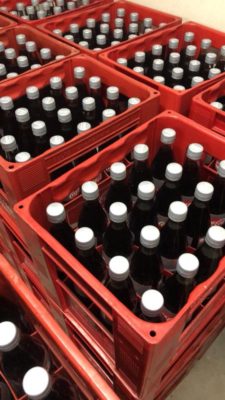Why you want it
This article is available as PDF as well.
As you probably know, I am addicted to Diet Coke, every few months I get a delivery of a four month supply of this wonderful drink.
It is a bit of a shlep to get all the Coke into the basement, so I wondered whether I could store it in the garage. Wouldn’t it be too cold in winter? I don’t think we have below freezing temperatures in there, but honestly I never went to check temperatures at 4:00 am in February. Also, wouldn’t it be too hot in summer?
With today’s technical means, these questions should be a piece of cake to solve. A temperature sensor for a few bucks, then hooking it up to power and maybe an ethernet cable… or wifi… — ok, maybe not as simple as I thought.
But then one can buy this stuff ready-made. Nice temperature sensors are out there, often coming with a beautiful casing, an easy to read screen, batteries, wifi — and a rather hefty $70 price tag. What? I the meantime I had devised a ton more options where I might need to measure temperature and had arrived at a point where 10 sensors didn’t suffice. But paying $700+ for all this? Insane!
I looked into Raspberry Pi computers, or even very small Raspberry Pi Zero W computers, coming with WiFi and everything I need. Except that (for the Pi Zero) «due to high demand we’re only selling ONE per customer». What a nuisance! Looking further, I found Arduino micro-controllers, essentially little computers that run one program only, could do the job at half price compared to the Pi Zero. And sure enough, there was a solution to my problem right there: https://www.losant.com/blog/getting-started-with-the-esp8266-and-dht22-sensor.
What to watch out for
I bought some of the necessary stuff (https://shopofthings.ch) and set to work. Following the instructions accurately is a good idea, but 2 items cost me a bit of time:
- As part of the initial setup, the instructions ask you to follow Environment Setup Instructions. On that page you’re asked to install additional libraries, the first one being called «PubSubClient». Don’t install from here — if you already did, simply delete it from the files in the Arduino subfolder on your disk and re-start the Arduino IDE.
Why? Well, you’re being told to make changes to the PubSubClient by following the instructions on https://forums.losant.com/t/sending-commands-with-larger-payloads/135:- Open the pubsubclient.h file from the Arduino libraries folder. On a Mac, this will be located at ~/Documents/Arduino/libraries/pubsubclient/src/PubSubClient.h
- Edit the MQTT_MAX_PACKET_SIZE to something larger. Increasing it to 256 seems to work pretty well.
- Recompile and reupload the firmware to the device.
However, I had no idea what to do with the final part of these instructions («Recompile and reupload the firmware to the device.»). Recompile?
The low-tech solution is to go to https://github.com/knolleary/pubsubclient/releases/tag/v2.7 and download the zipped library there. Then unzip it and make the changes as described, re-zip the package and then add it manually in the Arduino IDE software in Sketch/Include Library/Add .ZIP Library - The next library you’re supposed to install is «the latest version of ArduinoJson». Which I did, installing version 6.4.0-beta. However, in the accompanying picture of the instructions, version 5.13.2 is highlighted — and you have to use a 5.x.x version, otherwise it will not work. (see https://arduino.stackexchange.com/questions/54373/nodemcu-arduino-ide-dynamicjsonbuffer-was-not-declared-in-this-scope
And there I am: Logging temperature and humidity happily for less than $20 per device. (The micro-controller and sensor were $15, but you need a micro-USB cable and a USB charger as well if want to measure temperature elsewhere…)
